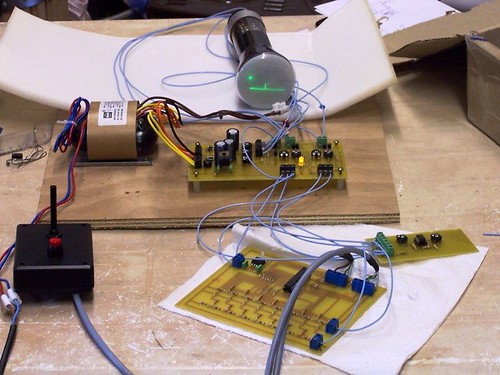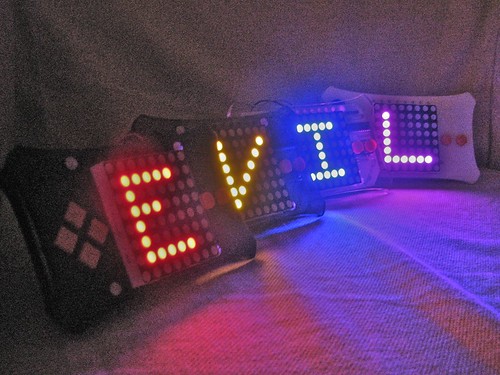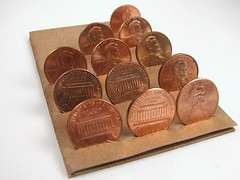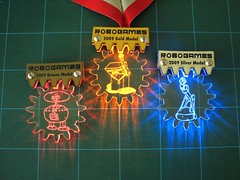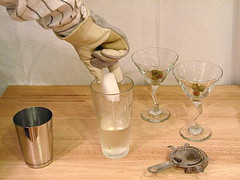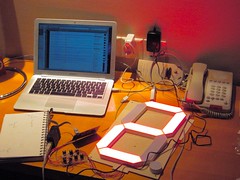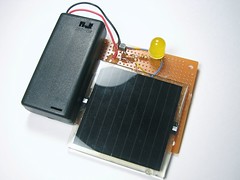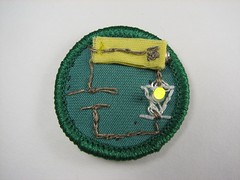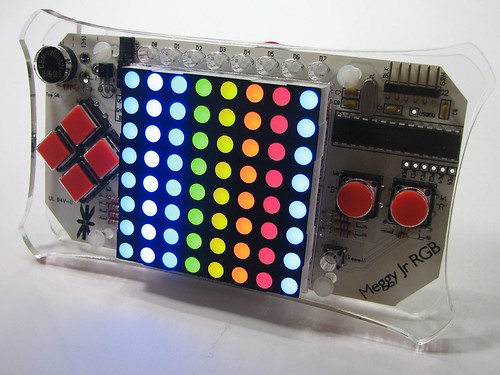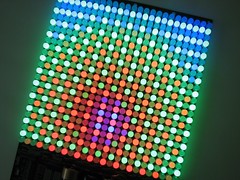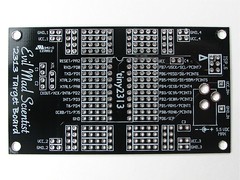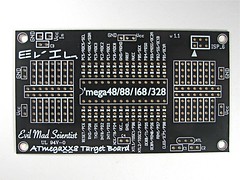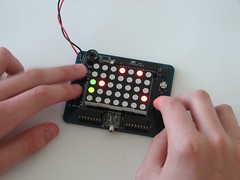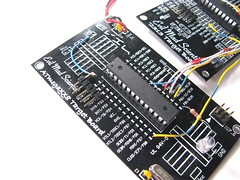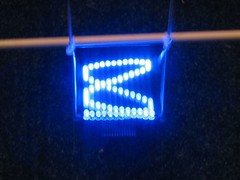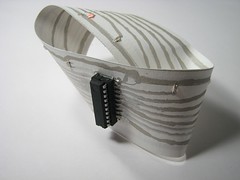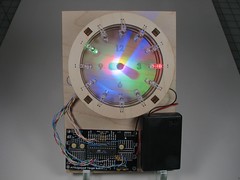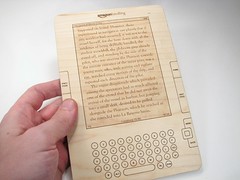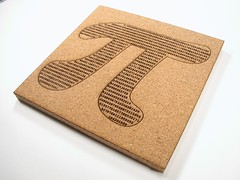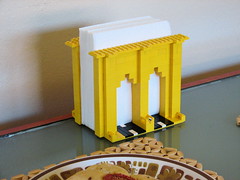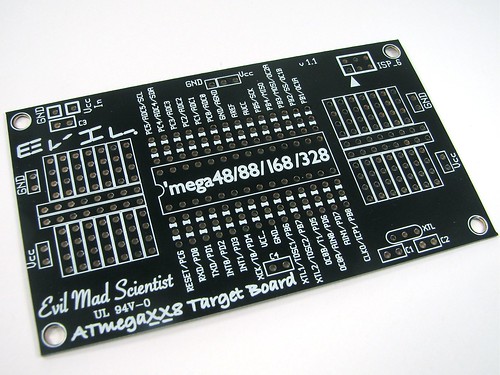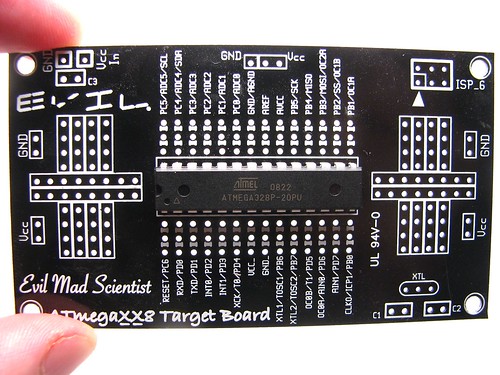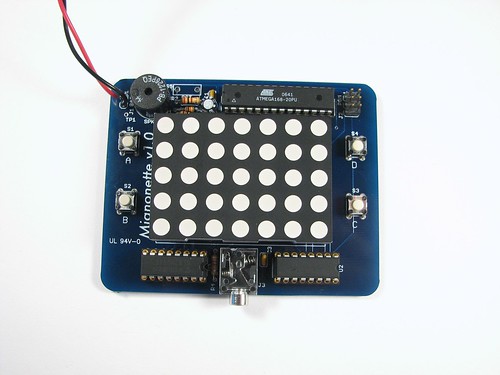We’ve seen a lot of great Arduino Halloween projects out there this year. A few of them have been submitted to our Arduino contest over at Instructables, and we’d love to see more. The entry deadline is Nov. 15, so you’ve still got time to send them in.
Speaking of contests, the Make Halloween contest deadline is here. Quick, get those microcontroller projects entered before midnight on Nov. 3!Category Archives: Microcontrollers
Instructables Arduino Contest
Over at Instructables, we’re sponsoring an Arduino contest with prizes including Meggy Jr RGB kits. The rules are simple: use Arduino in your project! And by Arduino, we mean any project involving the Arduino IDE in some way. (And yes, you can use your Meggy Jr RGB or your Peggy 2 for this contest.) We look forward to seeing your projects and would love to see them in the flickr auxiliary, too.
The Larson Scanner Kit

Today we’re releasing a new open-source project and kit, which is an updated approach to the “Larson Scanner.” The Larson scanner is named in honor of Glen A. Larson, the man responsible for producing both the original Battlestar Galactica and Knight Rider television shows, and consists of a set of red LEDs that scan back and forth.
Three years ago, we showed how to make a Cylon Jack-O-Lantern, in what has become one of our all-time most popular tutorials. The circuit for that project was based on a 555 timer, driving a 4017 decade counter, and has 6 pixels of resolution. To create the incandescent fading effect, we added low-pass transistor drivers. We also wrote up a version of that article for the 2007 Make Magazine Halloween special, which included a slightly nicer version of that same circuit.
And while it’s been popular, we’ve always had some nagging reservations about it, and in particular its battery life. This year, we decided to do something about it and made a much betterversion of the Larson Scanner, and so here it is:
More Tennis for Two
Romain saw our post on our Tennis for Two project and decided he wanted to make his own. He ordered a preprogrammed microcontroller from us and got to work. Once he was done, he was kind enough to share build photos and circuit diagrams with us.
Since he was starting with a bare CRT rather than a full scope, he built a wood and plexiglass enclosure which shows off the electronics very nicely.
We’re glad to see really retro gaming getting the attention it deserves!
Evil Mad Scientist Laboratories: Year 3
Happy birthday to us! Evil Mad Scientist Laboratories is now three years old.
To celebrate, we’re rounding up our most interesting projects from this past year.
Quick projects and observations:

The monetary density of things

Contact Lens Case Small Parts Tray
Simple LED Projects:

Quick, easy, temporary, and beautiful LED garden lights
Food Hacking:

South Indian Restaurant Menu Decoder

Improved Custom Message Hearts
CandyFab
Papercraft
Electronics Projects

Interactive LED Dining Table Circuit

Dark detecting jack-o’-lantern
Kit Projects
Crafty Projects
Microcontroller Projects

Tennis for Two, a video game from 1958
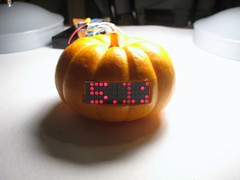
Scariest Jack-o’-Lantern of 2008
Geek Design
(Whew!)
Basics: Serial communication with AVR microcontrollers
One of the distinguishing characteristics of beginner-friendly microcontroller platforms– Arduino, PICAXE, and a few dozen others– is that they neatly wrap up and hide the nuts-and-bolts details of interfacing with the hardware.
Like everything else, it’s a blessing and a curse. The benefits are clear: A new user who has just acquired an Arduino can plug it in, blink an LED, and have a working demonstration of two-way serial communication in just a few minutes.
The drawbacks are a little harder to see. When you just use one line of initialization that calls a “library,” it’s easy to overlook exactly what’s involved: how many lines of code have invisibly been added to your program? What memory structures have been allocated? What interrupts are now going to disrupt program flow and timing? There’s also a portability issue. We often hear from people who got started with Arduino but now want to explore other AVR microcontroller systems, and don’t know how or where to start the migration process.
In what follows we discuss a minimal setup for serial communication with AVR microcontrollers, and give two example implementations, on an ATmega168 and on an ATtiny2313. While this fundamental “AVR 101” stuff, we’re approaching the problem (this time) from the migration standpoint. Suppose that you had an Arduino based project, where you relied on serial communication– using the library functions–between that hardware and your computer. From there, how would you migrate to a stand-alone AVR microcontroller with similar functionality, or even to a different microcontroller?
Continue reading Basics: Serial communication with AVR microcontrollers
Tiny portable AVR projects: ATtiny2313 breakout boards
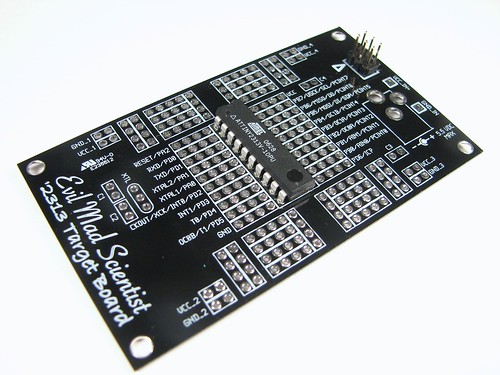
We use a lot of our ATmegaXX8 “business card” breakout boards for the ATmega168 microcontroller. We also still wire up a lot of minimal target boards to use the ATtiny2313 microcontroller, so here’s the missing piece: A simple breakout board for the ATtiny2313.
Continue reading Tiny portable AVR projects: ATtiny2313 breakout boards
Business card AVR breakout boards: Version 1.1
We’ve just released a new version of our super-handy business card sized target board for programming 28-pin AVR microcontrollers like the ATmega168 and ATmega328. These are just the thing for programming these chips through an ISP programmer like the USBtinyISP.
We use these for a lot of our simple microcontroller projects; Tennis For Two and the Lissajous POV come to mind. The new version has basically the same design but adds some extra prototyping area and makes the holes big enough to accept a ZIF socket:
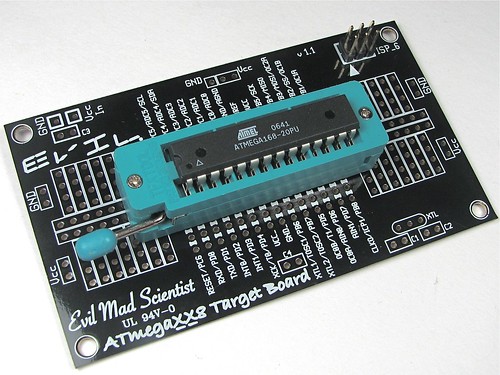
Like the original version of this target board, this circuit board is a fully open source hardware design. For much more information– including the detailed design files– please see the update that we’ve added to the end of our original article about this project.
ATmega328 in the wild
This will be interesting to a small subset of our readers, but we’re finally seeing ATmega328P chips in the wild. This is a new chip from Atmel that is nearly identical to– but with twice the memory of– the popular ATmega168 microcontroller, the microcontroller in the Arduino and in our (Arduino-compatible) Peggy 2.0. They are still in short supply, but they’ll be a lot of fun to play with. :)
In the photo is one of these on one of our “business card” AVR target boards that we designed for the ATmega48, ’88, ‘168, and ‘328, so it’s finally lived up to its name.
70 bits of gaming goodness
The Mignonette is a minimalist handheld gaming platform that we helped to design in a collaboration with Rolf van Widenfelt and Mitch Altman.
The Mignonette is based on an AVR microcontroller (either the ATmega88 or ATmega168) hooked up to drive a 5×7 bicolor red/green LED matrix display, for a grand total of 70 bits of gaming goodness under your total control.





